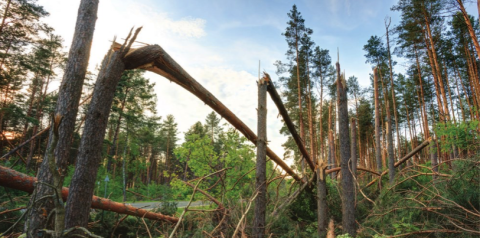
Natural disturbances such as tornadoes, ice storms or insect outbreaks can maintain forest diversity by creating a heterogeneous forest ecosystem. Yet, almost all forest landscapes are subject to multiple human- or animal-created stressors, which can deter plant diversity and forest recovery after natural disturbances. In the first large-scale field experiment that tested four simultaneous disturbances, a team of researchers led by forest ecologist Michelle Spicer is providing new insights into the impact of these disturbances on helping native plant species.
Using an area in western Pennsylvania that was struck by a tornado in 2012, the team picked four large tornado blowdowns where most of the overstory fell to the ground. Researchers compared the plant groups in the experimental area to undisturbed nearby forest areas, attempting to explain the effects of deer browsing, biomass changes and salvage logging on understory regeneration and plant species diversity.
“Salvage logging is really common,” says Spicer, assistant professor of Earth and environmental sciences. “There’s this big question of ‘is salvage logging good or bad?’ If you’re a landowner and you had planned on harvesting some of your forest in 10 years, then a tornado comes throughand blows down half the forest, you salvage some of the profits by logging at that point when the trees fell. That’s one of the things that’s actually really debated. Salvage logging has amuch lower impact than clear-cutting because the trees have already fallen down naturally. On the other hand, there’s a lot of carbon that has just gone into the understory. Maybe it would be good to leave it. In what context do we have these impacts?”
Spicer and her colleagues analyzed plant diversity and abundance of trees, herbs, shrubs and vines after the tornado blowdown. They discovered that deer had a negligible effect on regrowth, while the combination of natural windthrow and salvage logging had the greatest positive impact on understory plant communities. The herbaceous plant species were the major drivers of regeneration patterns, while tree species were largely unaffected by the intense disturbances.
The results highlight the need for greater consideration of nontree growth forms in forest ecology and management, particularly for the conservation of plant diversity, Spicer says. Scientists’ understanding of the mechanisms underlying the diversity and abundance of herbaceous plants lag far behind those of trees, though herbs make up the vast majority of temperate vascular plant species. The research contributes important data to forest disturbance models as well as changes the
views of effective eastern deciduous forest management practices to include herbs, shrubs and vines.
